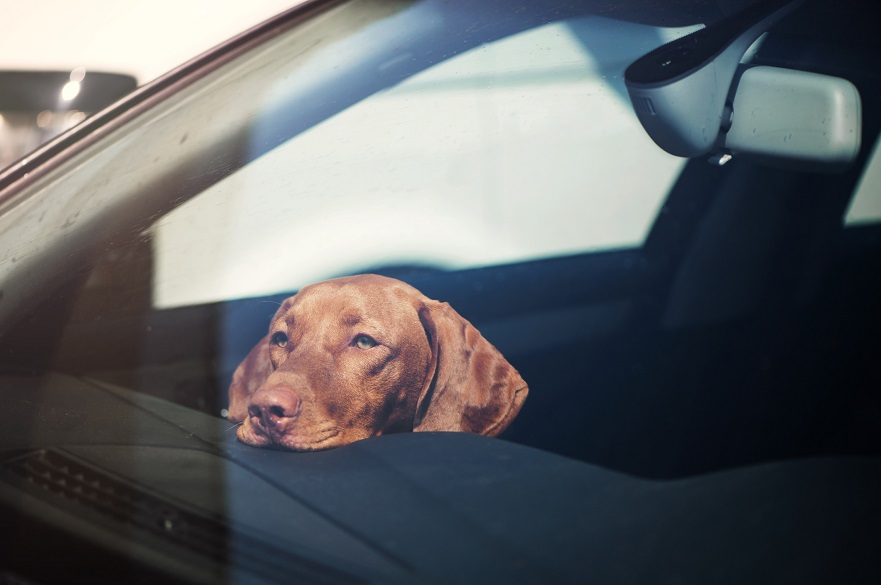Leaving dogs in cars is dangerous all year round, even winter, study shows
People are being warned about the dangers of leaving their dogs in parked cars after a study found that internal temperatures were hot enough all year round to pose a risk to dog health.

Researchers in dog welfare at Nottingham Trent University also found that – rather than midday being the hottest point of the day – the highest and therefore most dangerous internal temperatures occurred between 4-5pm.
The researchers, writing in the Open Veterinary Journal, monitored internal temperatures of UK cars – which had no dogs inside – continuously every day for two years as part of the study.
Most dogs are comfortable at temperatures between 15-25°C, but this is dependent on breed, coat length, fitness and a range of other factors.
The team found that temperatures exceeded 25°C in every month of the year, which is high enough to cause overheating in brachycephalic breeds – those with flat faces – such as bulldogs, French bulldogs and pugs.
And internal temperatures exceeded 35°C between April and September – hot enough to cause overheating in all dog breeds – with the internal temperature rising to this level on almost a third of all days from May to July.
Beyond 35°C, dogs will need to pant to control their temperature, and if they’re trapped in a hot car, panting stops being effective as the temperature and humidity rises.
The study also looked at the effect of time of day on car temperatures, finding that the interval between 4-5pm had the highest percentage of total temperature readings over 35°C.
The highest percentage of total temperature readings over 25°C, meanwhile, occurred between 3-4pm.
The highest temperature seen in the study was 54.5°C, which was recorded at 4.57pm in June 2018.
In enclosed vehicles dangerous microclimate conditions can develop due to the lack of air movement and this can result in reduced latent heat exchange for animals.
Early signs of heat stroke in dogs include panting, red or dark gums and tongue, confusion and unsteadiness leading to collapse, diarrhoea, vomiting and even seizuring leading to coma. If the dog is not cooled and treated by a veterinary surgeon quickly, the condition can be fatal.
The researchers say their findings suggest that annual campaignsto raise awareness of the risk of dogs becoming ill and dying in hot cars – which typically begin in May – need to start earlier in the year.
In a 2015 survey by the AA of more than 28,000 dog owners, 21% reported having left their dog unattended in a car for over 20 minute. The number of calls to the RSPCA about dogs in hot cars rose from 7,187 in 2016 to 8,300 in 2018.
“Our work shows an even bigger risk to leaving dogs in parked vehicles than previously thought,” said Dr Anne Carter, a researcher in Nottingham Trent University’s School of Animal, Rural and Environmental Sciences.
She said: “We know that some dog owners are already not heeding the warning message about the risk of leaving their dog in their vehicle.. People assume the risk is only midday during the summer, when in fact cars can reach potentially dangerous temperatures all year round, with late afternoon the hottest time period.”
“As heatstroke can be fatal in dogs, public awareness campaigns should consider launching in April or earlier, and also potentially include warnings about the increased risk to dogs in cars in the late afternoon.”
Emily Hall, a researcher and veterinary surgeon at Nottingham Trent University, added: “This work is also important as climate change is causing a rise in global temperatures and heatwaves are predicted to become more frequent and extreme.
“The risk is not limited to being left in a vehicle. Many modern cars are equipped with air conditioning, but older models may only have air vents or no ventilation mechanism at all in storage compartments.
“Dogs transported in these vehicles could be exposed to dangerously high internal temperatures during long journeys, particularly if the vehicle is stationary or queuing in the sun.”
Dogs Trust Veterinary Director, Runa Hanaghan, said: “Dogs should never be left alone in cars as even just a few minutes in a hot car can prove fatal. Sadly every year we hear of dogs getting in distress because they are left in cars on warm days, but what this important research shows is that we need to be alert to this all year round.
“Many people still believe it's OK if the windows are left open or they're parked in the shade, but the truth is, it's not and we strongly advise that dog owners should never leave their dog in a car, even if it feels cool outside.
“Dogs can’t cool down in the same way as humans and the heat can quickly become dangerous for them, so if you see a dog in a car in distress, call 999 immediately.”
The study also looked at the risk of storing non-refridgerated medications in vehicles, which might be at year-round risk of exceeding their licensed storage temperature limits which range from 8 to 25°C.
Last month it was revealed that researchers in dog welfare at Nottingham Trent University and the Royal Veterinary College had found that brachycephalic breeds were particularly at risk of developing heatstroke.
-
Notes for editors
Press enquiries please contact Dave Rogers, Public Relations Manager, on telephone +44 (0)115 848 8782, or via email.
The vehicles used in this study were generally kept in an unshaded carpark, reflecting the lack of consistent shading routinely available in UK carparks. No dogs were left unattended in cars in any part of this study.
Nottingham Trent University was named University of the Year 2019 in the Guardian University Awards. The award was based on performance and improvement in the Guardian University Guide, retention of students from low-participation areas and attainment of BME students. NTU was also the Times Higher Education University of the Year 2017, and The Times and Sunday Times Modern University of the Year 2018. These awards recognise NTU for its high levels of student satisfaction, its quality of teaching, its engagement with employers, and its overall student experience. The university has been rated Gold in the Government’s Teaching Excellence Framework – the highest ranking available.
It is one of the largest UK universities. With nearly 32,000 students and more than 4,000 staff located across four campuses, the University contributes £900m to the UK economy every year. With an international student population of more than 3,000 from around 100 countries, the University prides itself on its global outlook. The university is passionate about creating opportunities and its extensive outreach programme is designed to enable NTU to be a vehicle for social mobility. NTU is among the UK’s top five recruiters of students from disadvantaged backgrounds and was awarded University of the Year in the UK Social Mobility Awards 2019.
A total of 82% of its graduates go on to graduate entry employment or graduate entry education or training within six months of leaving. Student satisfaction is high: NTU achieved an 87% satisfaction score in the 2019 National Student Survey.
- Subject area: Animal, equine and wildlife
- Category: Press office; Research; School of Animal, Rural and Environmental Sciences


